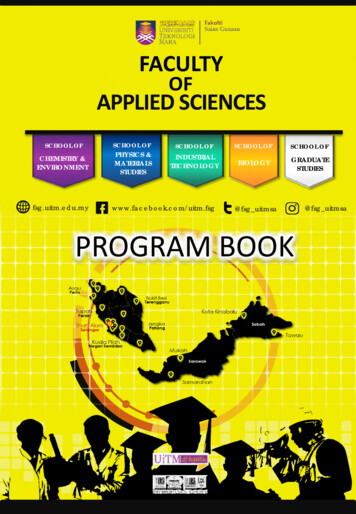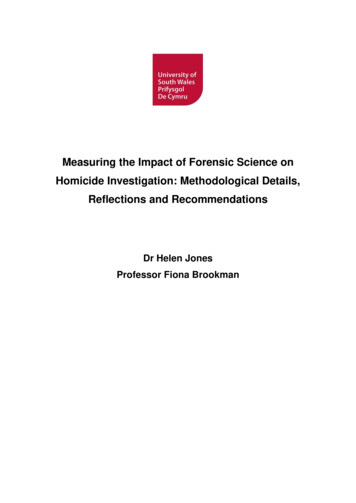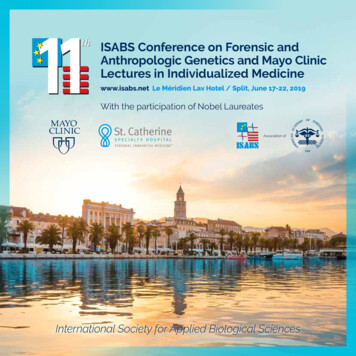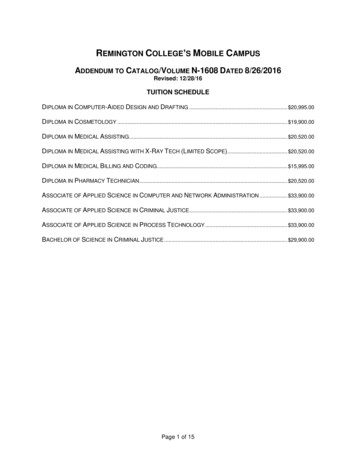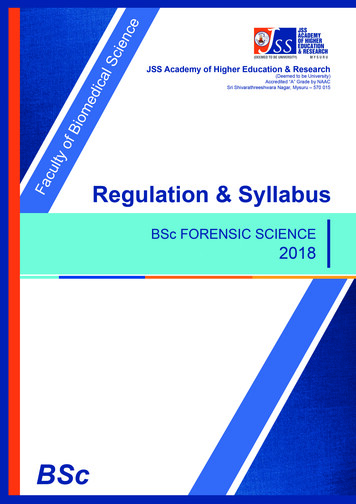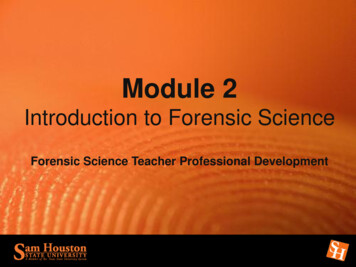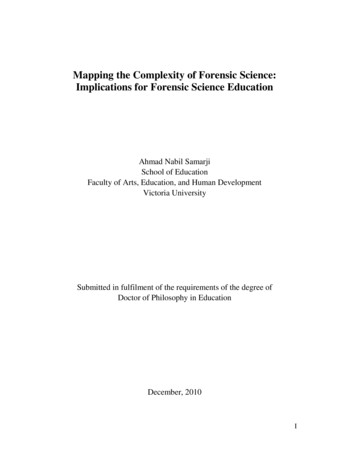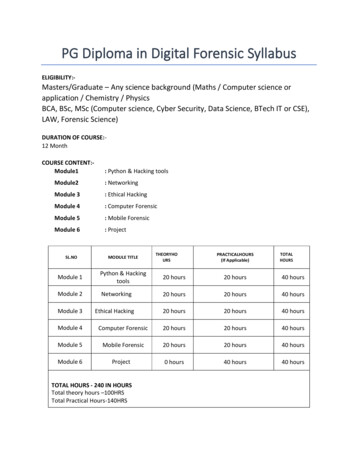
Transcription
PG Diploma in Digital Forensic SyllabusELIGIBILITY:-Masters/Graduate – Any science background (Maths / Computer science orapplication / Chemistry / PhysicsBCA, BSc, MSc (Computer science, Cyber Security, Data Science, BTech IT or CSE),LAW, Forensic Science)DURATION OF COURSE: 12 MonthCOURSE CONTENT:Module1: Python & Hacking toolsModule2: NetworkingModule 3: Ethical HackingModule 4: Computer ForensicModule 5: Mobile ForensicModule 6: ProjectTHEORYHOURSPRACTICALHOURS(If Applicable)TOTALHOURSSL.NOMODULE TITLEModule 1Python & Hackingtools20 hours20 hours40 hoursModule 2Networking20 hours20 hours40 hoursModule 3Ethical Hacking20 hours20 hours40 hoursModule 4Computer Forensic20 hours20 hours40 hoursModule 5Mobile Forensic20 hours20 hours40 hours0 hours40 hours40 hoursModule 6ProjectTOTAL HOURS - 240 IN HOURSTotal theory hours –100HRSTotal Practical Hours-140HRS
MODULE NUMBER 1: Python & Hacking tools (40Hours)THEORY (20 Hours)1. Installing Python on Linux and another Operating Systems &Introduction2. Using quotes and escape character,String Concatenation and RepeaterOperators3. Using Mathematical Operators with Numbers,len() with Lists4. Deleting List Element, Common list and operations, Accessing Dictionaryvalues5.Adding, Replacing and Deleting key-value pairs, Functions: get(), keys(),values() and items()6. Using for Loops,Using Sequence Operators and Functions with Strings7. Indexing and Slicing Strings,Handling ExceptionsPRACTICAL (20 Hours)8. Lambda Function (filter(), map()),Functions: Recursive function9. Importing Modules,Writing Modules10. Using Modules in Programs, The open Function, Input from TextFiles.4 Hrs2 Hrs2 Hrs2 Hrs2 Hrs4 Hrs4 Hrs5 Hrs5 Hrs10 HrsLEARNING OUTCOME1.The course is designed to provide Basic knowledge of Python. Python programming isintended for software engineers, system analysts, program managers and user supportpersonnel who wish to learn the Python programming language. Learning Outcomes: Problemsolving and programming capability.2. Understand what a comprehension is and the conditions for use.Translate a loop into a comprehension.Executed nested comprehensions.Integrate comprehensions with a data structure.3.To acquire programming skills in core Python.To acquire Object Oriented Skills in PythonTo develop the skill of designing Graphical user Interfaces in PythonTo develop the ability to write database applications in Python4. Through a series of hands-on exercises, students will learn to turn data into actionableinformation. The world is drowning in data. Each day 2.5 Exabytes of data (250 new Library ofCongresses built or 90 years of HD video) is produced. The problem is getting the data into a formatwhich can be used by tools that help in understanding and verifying the data. Python programming isrelatively quick to learn and has a great set of tools for importing, transforming, exploring, extractinginsights from, making predictions with, and exporting the data. This course introduces the majorPython tools used for preparing the data for analysis, the tools available for understanding the data,and using the data for insights and predictions. All class work and exercises are done in Python 3.x.5. To learn how to design and program Python applications. To learn how to use lists, tuples,and dictionaries in Python programs. To learn how to identify Python object types. To learnhow to use indexing and slicing to access data in Python programs.6.Its language constructs as well as its object-oriented approach aim to help programmerswrite clear, logical code for small and large-scale projects. . It supports multipleprogramming paradigms, including structured (particularly, procedural), object-oriented andfunctional programming.
Reference Books:1.2.3.4.5.6.Python Crash Course (Author: Eric Matthes)Learning Python (Author: Mark Lutz)Python Tricks: A Buffet of Awesome Python Features (Author: Dan Bade)Learn Python the Hard Way (Author: Zed Shaw)Automating Boring Stuff with Python (Author: Al Sweigart)Python for Data Analysis (Author: Wes McKinney)MODULE NUMBER 2 - Networking (40Hours)THEORY (20 Hours)1. LAN, MAN, WAN, Topology, Bits, Bytes and Octets4 Hrs2. What is Packet Tracer? & Packet Tracer Installation4 Hrs3. Introduction to IP and MAC Address,Use of IP and MAC Address2 Hrs4. IPv4(Classful Addressing), Public IP Private IP,Loopback Address and APIPA2 Hrs5. Default Subnet Mask,Calculate FLSM for Class C Address6. Calculate VLSM for 4-6 Network Requirement with variable Host, Briefexplanation for TCP Header7. Comparison between OSI and TCP/IP Model, DHCP Configuration using4pcs (Classful & Classless)2 HrsPRACTICAL (20 Hours)8. Configure DHCP Snooping with 2 Servers (DHCP Configured inside) and 4PCs, Configure Port Security (Restrict, Protect, Shutdown Mode) (Sticky,Dynamic MAC Address, Maximum Address)9. Explain Different WAN Technologies (Leased Line, Circuit Switching,Packet Switching), Explain and Configure different Point to Point Link5encapsulation technology (HDLC, PPP -- PAP, CHAP)10. Explain AAA and the working, Discuss the differences betweenTACACS and RADIUS2 Hrs4 Hrs10 Hrs5 Hrs5 HrsLEARNING OUTCOME1.Build multiple host and network architectures, given business requirements andconstraints; student will configure operating systems, network specific services, routing,switching, and remote access solutions2.The main emphasis of this course is on the organization and management of local areanetworks (LANs). The course objectives include learning about computer networkorganization and implementation, obtaining a theoretical understanding of datacommunication and computer networks, and gaining practical experience in installation,monitoring, and troubleshooting of current LAN systems. The course introducescomputer.3.Gain more knowledge. Networking is a great opportunity to exchange best practiceknowledge, learn about the business techniques of your peers and stay abreast of thelatest industry developments. A wide network of informed, interconnected contactsmeans broader access to new and valuable information.4. Network Analysis has become a widely adopted approach for studying the interactionsbetween agents, information and infrastructures. The strong demand for comprehensiveexpertise and skills in. Network analysis has been fueled by the widespread acknowledgementthat everything is connected, the popularity of social networking services, and advances incomputational solutions for collecting,visualizing and analyzing network data.
5. This interdisciplinary course introduces students to fundamental theories, concepts, methodsand applications of network analysis. We will focus on social, socio-technical and informationnetworks. Students learn how to approach network analysis in an informed, systematic andanalytically rigorousfashion. At the end of the course, students will be able to design, manage and execute networkanalysis projects for scholarly and commercial use, and to critically assess network studies.6.Demonstrate ability to select and apply a network analysis method (qualitative,quantitative, metrics, etc.) that is appropriate and feasible given the research question,dataset and scope of the project.Reference Books:1.Network Programmability and Automation.2.Computer Networking: A Top-Down Approach.3.Computer Networks.4.Network Warrior.5.Networking All-in-One for Dummies.6.Cisco Networking All-in-One for Dummies.MODULE NUMBER 3 – Ethical Hacking (40 Hours)THEORY (20 Hours)1. Brush up Linux (Optional), Brush up networking (Optional),What are the different types of hackers.2. Information Gathering,Scanning.4 Hrs3. System Hacking, System Hacking (Cont.), Reverse connection indifferent network using port forwarding.4. Show software-based vulnerabilities (Badblue/iceblaster), Explain LDAP2 Hrs5. Explain how Kerberos works (Authentication Server, Ticket GrantingServer, TGT etc.)6. Malware (Different types of Malware, Virus and Trojan)2 Hrs7. Man In the Middle Attack using the concept of ARP poisoning,Steganography.4 HrsPRACTICAL (20 Hours)8. Wireless Attacks, Website Attacks, Prevention9. Explain different kinds of sql injection attacks, explain cookie stealing,session hijacking.10. File upload vulnerability, Phishing Attack, DOS and DDOSattacks,Cloud based attacks4 Hrs2 Hrs2 Hrs5 Hrs5 Hrs10Hrs
LEARNING OUTCOME1.Plan a vulnerability assessment and penetration test for a network. Execute apenetration test using standard hacking tools in an ethical manner. Report on thestrengths and vulnerabilities of the tested network. Identify legal and ethical issuesrelated to vulnerability and penetration testing.2. The Certified Ethical Hacker salary in India for freshers starts from 3.5 LPA. If youbreak it down, the average salary of an Ethical Hacker in India turns out to be between 29k and 41k per month.3. There is no shortage of ethical hacking jobs in India. As per the 2019/2020 OfficialAnnual Cybersecurity jobs report, the demand for information security personnel willlead to an estimated 3.5 million unfilled jobs being created globally by 2021. The industrywill witness a 350% growth by 2021.4. The CBS article mentioned other major companies, including Square and Google, thatalso enlist professional hackers' help. Even Apple, whose products are famous for theirresistance to viruses, has hired hackers.5. Employment: The most basic way to make money hacking computers is to work for acompany as a penetration tester. . In return for the hacker disclosing what they foundthe company gives out a cash reward. Several companies such as Facebook, Intel,Snapchat, Cisco, Dropbox and Apple have bug bounty programs.6. Hacking is the act of finding the possible entry points that exist in a computer system or acomputer network and finally entering into them. Hacking is usually done to gain unauthorizedaccess to a computer system or a computer network, either to harm the systems or to stealsensitive information available on the computer.Reference Books:1) Hacking: The Art of Exploitation.2) The Basics of Hacking and Penetration Testing.3) The Hacker Playbook 2: Practical Guide to Penetration Testing.4) Penetration Testing – A Hands-On Introduction to Hacking.5) The Web Application Hacker’s Handbook: Finding and Exploiting Security Flaws6) Hacking: Computer Hacking, Security Testing, Penetration Testing, and Basic SecurityMODULE NUMBER 4 –Computer Forensic (40 Hours)THEORY (20 Hours)1. Computer Forensics in Today’s World4 Hrs2. Computer Forensics Investigation Process4 Hrs3. Understanding Hard Disks and File Systems2 Hrs4. Data Acquisition and Duplication2 Hrs5. Defeating Anti-Forensics Techniques2 Hrs6. Windows Forensics2 Hrs7. Linux and Mac Forensics4 HrsPRACTICAL (20 Hours)8. Linux and Mac Forensics5 Hrs9. Linux and Mac Forensics5 Hrs
10. Computer Forensics Investigation Process10 HrsLEARNING OUTCOME1.Workforce demand for Computer Hacking Forensic Investigators is on an all-time high acrossmultiple work options; major industries for CHFI hiring include law enforcement, military anddefense, enterprise IT, insurance and banking, legal practices, and of course cyber securityfirms.2. The Certified Ethical Hacker salary in India for freshers starts from 3.5 LPA. If you break itdown, the average salary of an Ethical Hacker in India turns out to be between 29k and 41k per month.3. From a technical standpoint, the main goal of computer forensics is to identify, collect,preserve, and analyze data in a way that preserves the integrity of the evidence collected so itcan be used effectively in a legal case.4. This paper proposes a detailed guideline model for digital forensics; the proposed modelconsists of five main phases, Preparation phase, Physical Forensics and Investigation Phase,Digital Forensics Phase, Reporting and Presentation Phase, and Closure Phase.5. Computer forensics can be a stressful field, as you often need to find information quickly for acriminal investigation and criminals can be highly skilled at technology. On the other hand, acomputer forensics career is in a top growing field that has many diverse employmentopportunities.6.Digital forensics is commonly used in both criminal law and private investigation. Traditionallyit has been associated with criminal law, where evidence is collected to support or oppose ahypothesis before the courts.Reference Books:1.Fraud,Kenneth C.Brancik, Insider Computer, Edition 2008, Auerbach Publications Taylor & FrancisGroup.2.William Oettinger, Learn Computer Forensics: A Beginner's Guide to Searching, Analyzing, andSecuring Digital Evidence, Edition 2020, Packet Publishing.3.Gerard Johansen, Digital Forensics and Incident Response: Incident response techniques andprocedures to respond to modern cyber threats, Second Edition, Packet Publishing.4.Joakim Kävrestad, Fundamentals of Digital Forensics: Theory, Methods, and Real-Life Applications,Edition 2018, Springer publications.5.John Sammons, The Basics of Digital Forensics: The Primer for Getting Started in Digital Forensics,Second Edition, Springer, 2014.MODULE NUMBER 5 -Mobile Forensic (40 Hours)THEORY (20 Hours)1. Network Forensics4 Hrs2. Investigating Web Attacks4 Hrs3. Mobile Data Recovery2 Hrs4. Dark Web Forensics2 Hrs5. Database Forensics2 Hrs
6. Cloud Forensics2 Hrs7. Investigating Email Crimes4HrsPRACTICAL (20 Hours)8. Mobile Data Recovery, IoT Forensics9. Dark Web Forensics5 Hrs5 Hrs10. Investigating Email Crimes, Malware Forensics10 HrsLEARNING OUTCOME1.Workforce demand for Computer Hacking Forensic Investigators is on an all-time high acrossmultiple work options; major industries for CHFI hiring include law enforcement, military anddefense, enterprise IT, insurance and banking, legal practices, and of course cyber security firms.2. The Certified Ethical Hacker salary in India for freshers starts from 3.5 LPA. If you break itdown, the average salary of an Ethical Hacker in India turns out to be between 29k and 41kper month.3. From a technical standpoint, the main goal of computer forensics is to identify, collect, preserve,and analyze data in a way that preserves the integrity of the evidence collected so it can be usedeffectively in a legal case.4. This paper proposes a detailed guideline model for digital forensics; the proposed model consistsof five main phases, Preparation phase, Physical Forensics and Investigation Phase, DigitalForensics Phase, Reporting and Presentation Phase, and Closure Phase.5. Computer forensics can be a stressful field, as you often need to find information quickly for acriminal investigation and criminals can be highly skilled at technology. On the other hand, acomputer forensics career is in a top growing field that has many diverse employmentopportunities.6.Digital forensics is commonly used in both criminal law and private investigation. Traditionally ithas been associated with criminal law, where evidence is collected to support or oppose ahypothesis before the courts.Reference Books:1.John R. Vacca, Charles River Media, Computer Forensics: Computer Crime Scene Investigation, 2ndEdition, 20052, ChristofPaar, Jan Pelzl, Understanding Cryptography: A Textbook for Students and Practitioners,2010, Second Edition, Springer’s.3.Ali Jahangiri, Live Hacking: The Ultimate Guide to Hacking Techniques & Countermeasures forEthical Hackers & IT Security Experts, First edition, 20094.Barkhs and U. Rama Mohan, Cyber Law Crimes, Third Edition,2017,Asia Law House5.ViveekSood, Cyber Laws Simplified, Fourth reprint 2008,McGraw Hill.6.M. Merkow, & J. Breithaupt, Information security: Principles and practices, Second Edition, 2006,Upper Saddle River, NJ:Prentice HallMODULE NUMBER 6 – Project (40 Hours)THEORY (0 Hours)1.NANAHrs
2. NAHrs3. NAHrs4. NAHrs5. NAHrs6.NAHrs7.NAHrsPRACTICAL (40 Hours)8. Report Writing10 Hrs9. Industrial training internship for Digital forensic investigation10 Hrs10. Client site visit for data recovery work20 Hrs
6) Hacking: Computer Hacking, Security Testing, Penetration Testing, and Basic Security MODULE NUMBER 4 -Computer Forensic (40 Hours) THEORY (20 Hours) 1. Computer Forensics in Today's World 4 Hrs 2. Computer Forensics Investigation Process 4 Hrs 3. 2 Understanding Hard Disks and File Systems Hrs 4. Data Acquisition and Duplication 2 Hrs 5.
